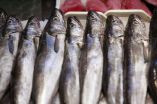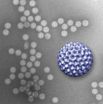(Press-News.org) Some European wolves have a distinct preference for wild boar over other prey, according to new research.
Scientists from Durham University, UK, in collaboration with the University of Sassari in Italy, found that the diet of wolves was consistently dominated by the consumption of wild boar which accounted for about two thirds of total prey biomass, with roe deer accounting for around a third.
The study analysed the remains of prey items in almost 2000 samples of wolf dung over a nine year period and revealed that an increase in roe deer in the wolf diet only occurred in years when boar densities were very low. In years of high roe deer densities, the wolves still preferred to catch wild boar.
The results are published in the journal PLOS ONE.
The research team related the prey remains in wolf dung to the availability of possible prey in part of Tuscany, Italy - an area recently colonised by wolves. The findings have implications for wildlife conservation as the impact of changing predator numbers on prey species is important for managing populations of both predators and prey.
Lead author, Miranda Davis, from the School of Biological and Biomedical Sciences at Durham University, said: "Our research demonstrates a consistent selection for wild boar among wolves in the study area, which could affect other prey species such as roe deer."
"Intriguingly, in other parts of Europe where red deer are also available, wolves appear to prefer this prey to wild boar, suggesting that they discriminate between different types of venison."
In Europe, the wolf (Canis lupis) is recovering from centuries of persecution and the expansion of wolf populations has the potential to change the ecology of communities of ungulates (hooved animals) by exposing them to natural predation by wolves, according to the researchers.
The preference for boar is in contrast to other areas of Europe where wolves often avoid boar as prey. One factor may be the relatively smaller size of Mediterranean boar, making them less dangerous to wolves in Mediterranean regions, compared to the larger-sized boar that roam other parts of Europe.
Co-author, Dr Stephen Willis, from the School of Biological and Biomedical Sciences at Durham University, said: "Wolves were hunted to extinction in the UK, probably by the end of the 17th century. Our findings from Italy suggest that if they were reintroduced into an area with a healthy ungulate population their impact on livestock could be minimal."
Tuscany's woodlands support populations of both roe deer and wild boar, and are also grazed by sheep, goats and cattle; however, wild boar and roe deer made up over 95 per cent of wolf diet in the study area, with very little evidence of livestock predation.
The scientists identified prey items from fragments of bones and hair in the wolf dung collected in the region. The prey categories included wild boar, roe deer, red deer, hare, small rodents, goats, sheep and cattle.
For more than five years of the study, the percentage of wolf diet made up of wild boar was more than twice that of roe deer. Other prey represented only a very small proportion of the diet.
The researchers believe that further dietary studies are essential for understanding the true impact of wolves on European wildlife over time.
Co-author, Dr Phil Stephens, from the School of Biological and Biomedical Sciences at Durham University added: "Wolves and brown bears are gradually returning to their former strongholds in Europe. Understanding the needs of these species, as well as their potential impacts, is going to be fundamental to managing that welcome return."
###
The project was part-funded by a Durham University Doctoral Fellowship and the Regional Government of Tuscany and the Province of Arezzo also provided logistical support throughout the study.
END
A researcher at the Auburn University Museum of Natural History and Department of Biological Sciences has reported the discovery 33 new trapdoor spider species from the American Southwest. These newly described species all belong to the genus Aptostichus that now contains 40 species, two of which are already famous – Aptostichus stephencolberti and Aptostichus angelinajolieae.
The genus now includes other such notable species as Aptostichus barackobamai, named for Barack Obama, the 44th President of the United States, and reputed fan of Spiderman comics; Aptostichus edwardabbeyi, ...
CAMBRIDGE, Mass. -- In most cities, traffic growth has outpaced road capacity, leading to increased congestion, particularly during the morning and evening commutes. In 2007, congestion on U.S. roads was responsible for 4.2 billion hours of additional travel time, as well as 2.8 billion gallons of fuel consumption and an accompanying increase in air pollution.
One way to prevent traffic tie-ups is to have fewer cars on the road by encouraging alternatives such as public transportation, carpooling, flex time and working from home. But a new study — by researchers at MIT, ...
What is most important when buying fish: the price, the country of origin, whether it is fresh or frozen or whether it is wild or farm-raised? The average Spanish consumer prefers above all that their fish comes from Spain, according to a study published in the 'Food Quality and Preference' journal. Spain is the largest producer of fish in the European Union but in recent years its population has consumed less fish, especially seafood.
A team of scientists brought together nearly 900 consumers from nine Autonomous Communities (Andalusia, Asturias, the Balearic Islands, ...
CAMBRIDGE, Mass. -- Following up on earlier theoretical predictions, MIT researchers have now demonstrated experimentally the existence of a fundamentally new kind of magnetic behavior, adding to the two previously known states of magnetism.
Ferromagnetism — the simple magnetism of a bar magnet or compass needle — has been known for centuries. In a second type of magnetism, antiferromagnetism, the magnetic fields of the ions within a metal or alloy cancel each other out. In both cases, the materials become magnetic only when cooled below a certain critical temperature. ...
If the key to winning battles is knowing both your enemy and yourself, then scientists are now well on their way toward becoming the Sun Tzus of medicine by taking a giant step toward a priceless advantage – the ability to see the soldiers in action on the battlefield.
Investigators at the Virginia Tech Carilion Research Institute have invented a way to directly image biological structures at their most fundamental level and in their natural habitats. The technique is a major advancement toward the ultimate goal of imaging biological processes in action at the atomic ...
We use many different types of chemicals and plastics for the convenience of our everyday life. The current sources of these materials are provided from petrochemical industry, using fossil oil as a raw material. Due to our increased concerns on the environmental problems and fossil resource availability, there has been much interest in producing those chemicals and materials from renewable non-food biomass through biorefineries. For the development of biorefinery process, microorganisms have successfully been employed as the key biocatalysts to produce a wide range of ...
PHILADELPHIA—Researchers at the Kimmel Cancer Center at Jefferson (KCC) (insert link to "Kimmel Cancer Center at Jefferson" www.kimmelcancercenter.org) have developed potentially game-changing diagnostic and prognostic genetic tests shown to better predict prostate cancer survival outcomes and distinguish clinically-relevant cancers.
The team, led by Richard G. Pestell, M.D., Ph.D., Director of the KCC and the Chair of the Department of Cancer Biology at Thomas Jefferson University, report their preclinical findings from a blinded, retrospective analysis of over 350 ...
As the human population increases, so too do the demands and stresses on agriculture. In the January 2013 issue of International Journal of Plant Sciences, Penn State University Waller Professor of Plant Biology Dr. Sarah Assmann explores how the responses to environmental stresses by one small, genetically diverse plant species might illuminate possible approaches to addressing growing human demand for crop products amid decreasing resources.
In the article, Dr. Assmann describes how human population growth presents new challenges to twenty-first-century agriculture, ...
A University of Colorado Cancer Center study in this month's edition of the Journal of Investigative Dermatology describes a new target and potential treatment for melanoma, the most dangerous form of skin cancer. MicroRNA can decide which genes in a cell's DNA are expressed and which stay silent. Melanoma tends to lack microRNA-26a, which makes the gene SODD go silent.
"It's a double negative," says Yiqun Shellman, PhD, investigator at the CU Cancer Center, associate professor at the CU School of Medicine, and the study's co-senior author. "miR-26a works to stop the ...
New research examining the role of race and ethnicity in an individual's decision to become a donor for hematopoietic cell transplantation (HCT) identifies several factors associated with varied participation rates in national donor registries across racial/ethnic groups. Results of this first-of-its-kind study are published online today in Blood, the Journal of the American Society of Hematology (ASH).
Hematopoietic cell transplants serve as valuable treatments for a range of blood disorders, as they generate new, healthy blood cells to replace diseased cells. While ...


